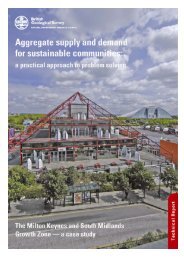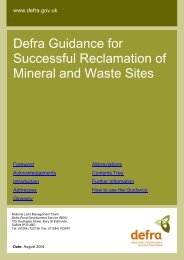creating environmental improvements through biodiversity
creating environmental improvements through biodiversity
creating environmental improvements through biodiversity
Create successful ePaper yourself
Turn your PDF publications into a flip-book with our unique Google optimized e-Paper software.
Sustainable Aggregates Creating Environmental Improvements <strong>through</strong> Biodiversity<br />
Dissemination:<br />
Draft recommendations are to be discussed with project partners to ensure practicality, and a wider<br />
discussion workshop is to be held to obtain alternative views.<br />
The proposal implies that the end-report would be distributed to all stakeholders (including Environment<br />
Agency, Natural England, English Heritage, mineral operators etc.)<br />
THE INFLUENCE OF AGGREGATE QUARRYING IN RIVER FLOODPLAINS<br />
ON FLOOD RISK AND BIODIVERSITY (MIRO MIST, DEFRA)<br />
Jamie Clayton, Alan Thompson, Alex Harper, Marc Pinnell (Symonds Group), Chris Pointer, Susan Willard,<br />
David Roberts (RMC Aggregates (UK) Ltd.), Duncan Wardrop (Lafarge Aggregates Ltd.) 2004<br />
Project Type: Modelling, review and recommendations<br />
Site: River Uck floodplain (flood risk), various case study sites (<strong>biodiversity</strong>)<br />
Project Aim: To assess the influence of aggregate quarrying in river floodplains on flood risk and<br />
<strong>biodiversity</strong>, and identify ways to optimise beneficial effects<br />
Main methods:<br />
Flood risk –<br />
Identification of quarries at risk of flooding, and useful case studies<br />
Modelling effects of quarries on flood impact<br />
Biodiversity –<br />
Search for sites with ecological records before, during or after extraction<br />
Qualitative review, with case studies, of the influence of restoration techniques and management practices on<br />
distinct animal groups and habitat types<br />
Output (flood risk section):<br />
Models of quarry influences on flood events<br />
Illustration that active quarries can reduce flood severity by providing storage capacity<br />
Illustration that quarries restored to open water can reduce flood severity by providing some storage<br />
capacity<br />
Illustration that re-vegetation of land around a quarry can retard flow rates<br />
Output (<strong>biodiversity</strong> section):<br />
Review of habitat types that have been created on disused floodplain aggregate sites, including advice on<br />
features to consider in restoration proposals<br />
Review of habitat requirements for different taxa (mainly animal), with case studies on benefits for these of<br />
restoration<br />
Recommendations on approaches to habitat creation and management on quarry sites, and on monitoring<br />
during and after extraction<br />
Identification of a gap in ecological information on quarry sites, other than for those with known ecological<br />
value, and in recorded results of habitat creation<br />
Recommendation for pre-planning baseline ecological assessments of all proposed mineral sites, to help guide<br />
restoration programmes, future management and any mitigation<br />
Recommendation to consider effects on pre-extraction <strong>biodiversity</strong> at the planning stage<br />
Recommendation to consider species that may use the active site<br />
Suggestion for a co-ordinated strategy across the industry to help achieve the best balance in addressing BAP<br />
targets<br />
54

















